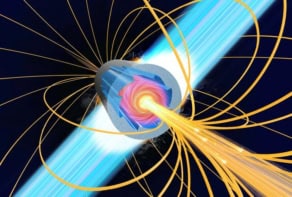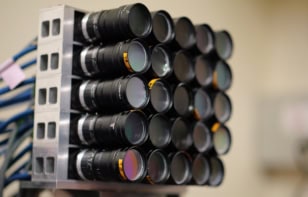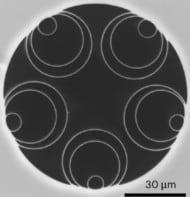Light has been used to diffract electrons coherently for the first time, nearly seventy years after the phenomenon - known as the Kapitza-Dirac effect - was predicted. The observation was made possible by powerful modern lasers and highlights the wave and particle nature of matter. Herman Batelaan and colleagues at the University of Nebraska hope to exploit the effect to build an electron interferometer that is ten thousand times more sensitive than existing devices based on light (D Freimund et al 2001 Nature 413 142).
In 1933 Peter Kapitza and Paul Dirac predicted that a standing light wave would act as a ‘light grating’ that could diffract electrons. But light interacts only weakly with electrons, and early attempts to detect coherent electron diffraction failed because the available light sources were too weak.
To form the grating, Batelaan and co-workers directed two powerful pulsed lasers towards each other to create a standing wave several millimetres in length. The maxima of this wave pattern were 266 nanometres apart, half the wavelength of the laser light. A narrow beam of electrons was sent through the grating, and detectors placed 24 centimetres behind the grating map the distribution of the diffracted electrons.
As the team hoped, the profile had a central maximum flanked by weaker peaks, each separated by 55 micrometres, as predicted by Bragg’s law. The heights of the peaks differed slightly from those predicted by Schrödinger’s equation, which describes both the particle and wave nature of all matter. Batelaan and colleagues attribute this discrepancy to imperfect overlap of the lasers that form the grating.
Importantly, the diffracted electron beams keep the same phase relationship after they have passed through the grating. Interferometry – a powerful probe of the structure of matter – is based on the splitting and recombination of such coherent beams. If the phases of the beams stay the same, they recombine ‘constructively’ to give a strong signal. But if one beam passes through a sample of matter, its phase changes and the recombined beams produce a weaker signal. The exact intensity of the signal reveals certain properties of the matter.
As Batelaan explains, an electron interferometer could be extremely sensitive because the wavelength associated with electrons is around ten thousand times shorter than that of light. “Very small effects could cause a shift in the phase of an electron beam”, Batelaan told PhysicsWeb. “We could detect the tiny electromagnetic fields associated with atoms and particles”.


